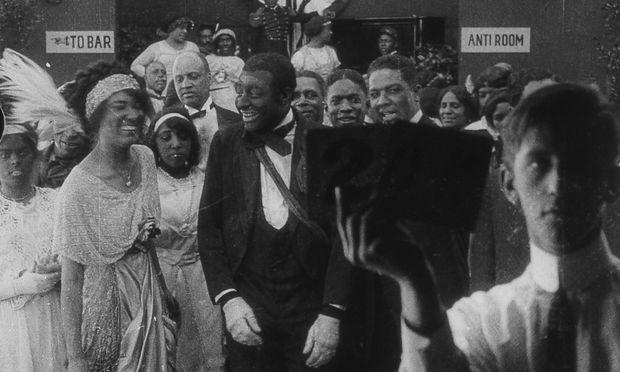New York’s MoMA debuts long-lost footage from the dawn of blacks in American film
Footage from what may be the earliest surviving feature film with a black cast, made in 1913.
Curators at the Museum of Modern Art recently restored the earliest known surviving footage of a feature length film with a black cast. The footage, shot in 1913 in Harlem, features Bert Williams and a number of other black performers.
This week, an hour of the surviving footage premiered at the New York City Museum of Modern Art as part of an exhibition called "100 Years in Post-Production: Resurrecting a Lost Landmark of Black Film History."
Jacqueline Stewart, a professor of cinema and media studies at the University of Chicago, calls the film an "extraordinary find."
“Only a tiny fraction of silent films have survived at all, and the records that we have of black participation in the film industry during the silent period is miniscule," Stewart says. "Having this moving document of black performers is really extraordinary and helps us to fill in a number of gaps that we have in the history of black performance on films.”
The footage was acquired by the founder of the MoMA Film Library, Iris Barry, in the late 1930s and was housed in the museum’s archives for decades. Stewart says the film captures the Vaudeville era, which began in the 1880s and ran through the 1920s, and helps researchers advance their understanding of American silent filmmaking, and black performance in film.
“The footage that we have here demonstrates a real kind of continuity between the live stage and film performance during this period,” she says. “The issue of how natural black performers are on film is a really interesting question during this time. Certainly these representations are structured by stereotypes.”
During the time, black performers were expected to adhere to the theatre conventions of the era, including blackface minstrelsy. Williams was a central star of the Vaudeville period, and as a light-skinned black man, Stewart says he too had to don blackface.
“[Williams] was a virtuoso performer who wore the blackface mask in his stage performances, and he does so in this footage,” she says. “It’s a convention that he’s using that demonstrates how influential minstrel performance was at the time, even for black actors.”
The film obtained by MoMA is not complete, and Stewart says that the movie was never finished or released. The footage shows the actors doing multiple takes, and it reveals a great deal about the acting of the era.
“What we can see is how the actors are calibrating their performances — improving things or making adjustments take to take,” she says. “There again is why I think it’s so interesting to study this footage. What we’re getting is not simply a continuation of what people did on stage, but a rethinking of how stage performances can be translated to film.”
Williams is the main character of the film, playing “a man about town” who is trying to win the hand of the “local beauty,” portrayed by Odessa Warren Grey, says Stewart.
“My favorite scene in this footage is a kissing scene at the very end when Williams does indeed win the hand of Odessa Grey,” she says. “We get multiple takes of the two of them kissing. It seems as if though the extended duration of the kiss is supposed to fade to black, but because this isn’t a finished film, we just get multiple takes of them with their lips touching.”
During this early era of film, actors were beginning to evolve with technology —t hey came to understand the power of the close up, something that was never an issue during stage performances.
“Another important thing to note about the closer framing that you get in this footage is that we can really see Williams’ blackface as an application,” says Stewart. “This is not a naturalistic mode of costuming — you can see the edge of the wig that he is wearing.”
Though stage audiences knew actors like Williams were in blackface, Stewart says the camera is able to show the costume in new ways.
“To see [Williams] performing alongside all of these other actors who are not in blackface, it really de-naturalizes blackface,” she says. “It gets us to appreciate the range of performance types and visual styles that black performers could bring to their film performances.”
